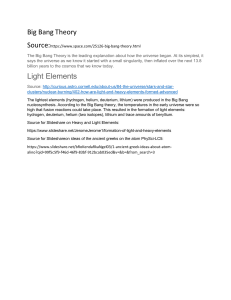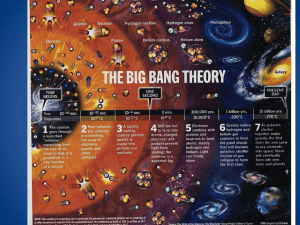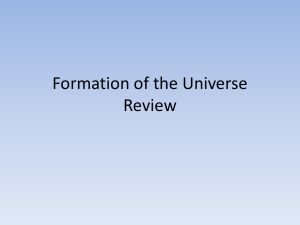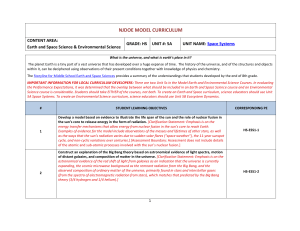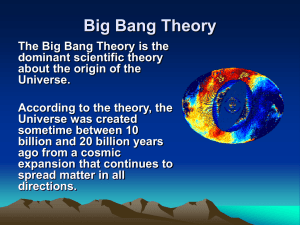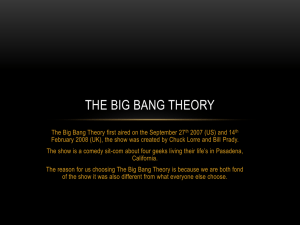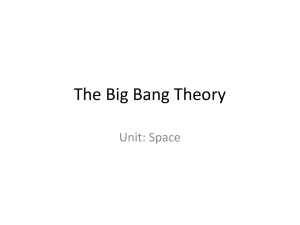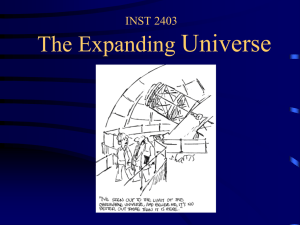slides
advertisement
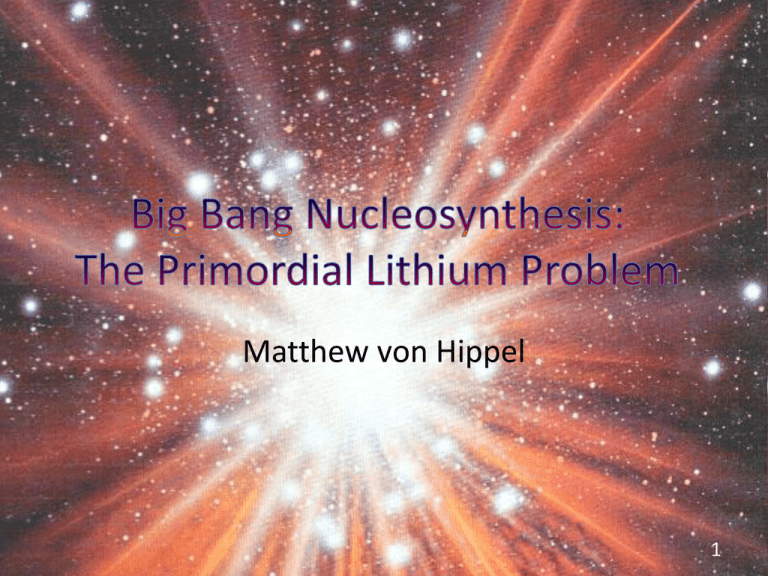
Matthew von Hippel 1 Outline • • • • • • What is Big Bang Nucleosyntheis? How does it work? How can we check it? The Primordial Lithium Problem Problem or problem? Possibility of New Physics 2 “We are star-stuff” –Carl Sagan • Well not exactly. Many elements come from stars or supernovae, but the lightest need another origin • Hence, Big Bang Nucleosynthesis (BBN) 3 Big Bang Nucleosynthesis • First proposed by Ralph Alpher, Hans Bethe, and George Gamow, 1948 – Bethe wasn’t actually involved in the research, but was added for the alphabeta-gamma pun • They proposed that all elements were formed in the Big Bang. This turns out to be false: there is no stable nucleus of mass number five or eight, which prevents the process from going beyond Lithium. 4 BBN At a Glance • Einstein’s Equations in a universe with an isotropic distribution of matter and energy give us the Friedmann Equations: 𝑎2 𝑡 𝑎2 𝑡 𝑘𝑐 2 + 𝑅2 𝑎 2 𝑡 0 = 8𝜋𝐺𝑁 3 𝜌 𝑎 (𝑡) 𝑎(𝑡) =− 4𝜋𝐺𝑁 𝑐2 1 3 (𝑝 + 𝜌𝑐 2 ) Where a(t) is a universal scale factor and k is related to the universe’s curvature • With these and the equation of state for gas we can write the scale factor in terms of the density • The early universe was very hot, thus dominated by radiation. Because of this the density near the Big Bang is approximately the radiation density, which thermodynamics lets us relate to the temperature • Put all this together, and we get −1 𝑇~𝑎 5 The Reactions • From this relation, we get the temperature of the early universe, which tells us which reactions take place • Light elements are produced by the following reactions: + 𝑝+𝑛 𝐷+ + 𝑝 3 + 𝐻 +𝑝 4 𝐻𝑒 + 𝐷 3 𝐻𝑒 ++ + 𝛾 4 𝐻𝑒 ++ + 𝛾 6 𝐿𝑖 + 𝛾 𝐷 +𝛾 3 + 𝐷+ + 𝑛 𝐻 +𝛾 3 4 𝐻𝑒 ++ + 𝑛 𝐻𝑒 ++ + 𝛾 4 𝐻𝑒 + 3𝐻 7 𝐿𝑖 + 𝛾 • Inputting 11 key nuclear cross sections, the baryonphoton ratio, and the neutron lifetime, we can predict the relative abundances of Deuterium, Lithium-7, Helium-3, and Helium-4 compared to Hydrogen 6 Cosmic Microwave Background • The angular power spectrum of the Cosmic Microwave Background can give us a value for the baryon-photon ratio • The ratio of heights between odd and even peaks increases with baryon density. Other parameters move the peaks in synch • There were some early discrepancies, but more recent measurements (WMAP) give baryon-photon ratio 6.23±0.17 • This is then used in the BBN formulas 7 What do we compare it to? • To observe whether the ratios calculated by BBN hold, we measure old parts of the universe where fusion has been of limited scope. In particular, three areas for Lithium: Metal-poor halo stars: Li in these stars correlates with Fe, so by taking Fe to zero we get a value for Li in the early universe Globular clusters: Similar situation Metal-poor high velocity clouds: Not pursued in detail yet, may offer a check on the above two 8 What do we get? • Yellow and Empty curves are observations, Blue is theory • Y=He/(H+He) • Helium 3 is hard to measure, since most stars burn it, so there is no yellow curve • Remaining curves within expected error…except Lithium. Is this a problem? 9 Problems vs. problems • To find discrepancies that indicate new physics, we first have to be sure the discrepancy isn’t caused by more prosaic sources of inaccuracy in our measurements/calculations. – Essentially, whether it is a Problem that can spark a new theory, or merely a problem with our current calculation • What else could go wrong? – Nuclear Cross Sections: in general, we might have missed some key nuclear reactions that reduce cosmic Lithium. However, the nuclear theory involved is well understood. Those parts that are more poorly understood are constrained by the role they play in models of stars, which end up meaning that corrections here will likely be in the wrong direction. – More observations: current observations could be supplemented by unexplored areas(high velocity clouds). However, we will likely still have to use halo stars as a standard measurement, so this might cause dramatic change. 10 New Physics! • If it really is a Problem, not just an issue with our methods, then that means new physics. • In general: – Today’s Li-7 from primordial Li-7 and Be-7. In the early universe the following reaction would get rid of Be-7: 7 𝐵𝑒 + 𝑛 7 𝐿𝑖 4 4 𝐻𝑒 + 𝐻𝑒 where Li-7 is destroyed by proton reactions – So to reduce Li, we need more neutrons. • WIMP decays an early speculation, but insufficient • Decays of GeV scale SUSY particles might bring more neutrons through more complex paths (Pospelov and Pradler, 2010) 11 Conclusion • Big Bang Nucleosynthesis allows predictions of present-day light element abundances, once we have CMB anisotropy data • These match observations well, except for Lithium • The missing Lithium is likely a sign of physics beyond the standard model 12 Bibliography • Cheng, T.-P. (2005). Relativity, Gravitation, and Cosmology: A Basic Introduction. Oxford, Oxford University Press. • Cyburt, R. H. and et al. (2008). "An update on the big bang nucleosynthesis prediction for 7 Li: the problem worsens." Journal of Cosmology and Astroparticle Physics 2008(11): 012. • Kaplinghat, M. T., Michael S. (2001). "Precision Cosmology and the Density of Baryons in the Universe." Physical Review Letters 86(3): 4. • Pospelov, M. a. P., Josef (2010) Metastable GeV-scale particles as a solution to the cosmological lithium problem. arXiv:1006.4172 • Turner, M. S. (1996) Big-bang Nucleosynthesis: Is the Glass Half Full or Half Empty? arXiv:astro-ph/9610158v1 13
